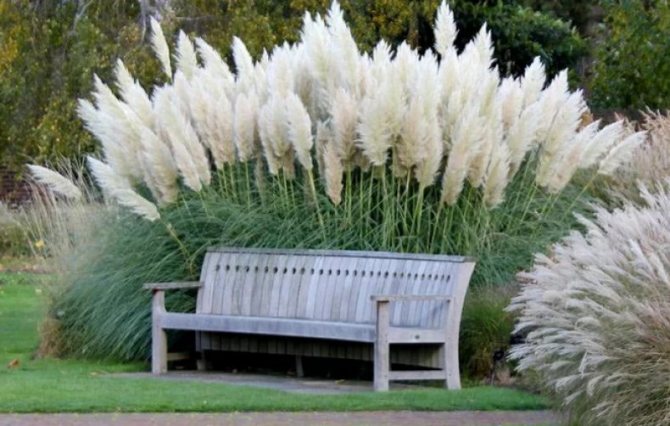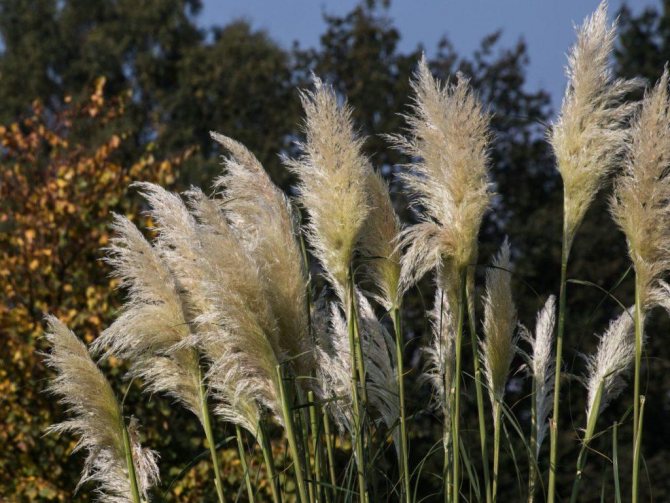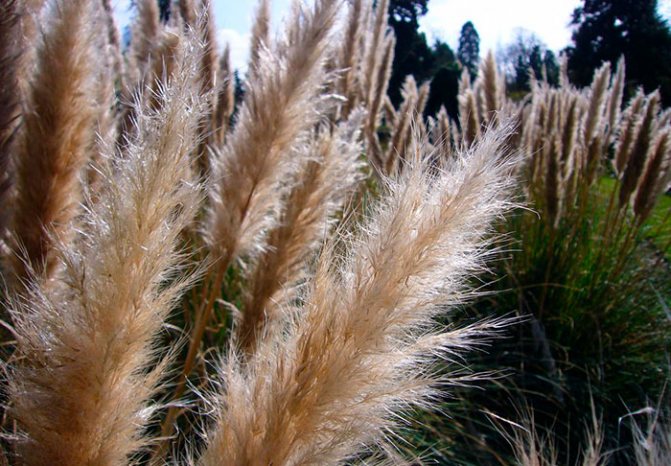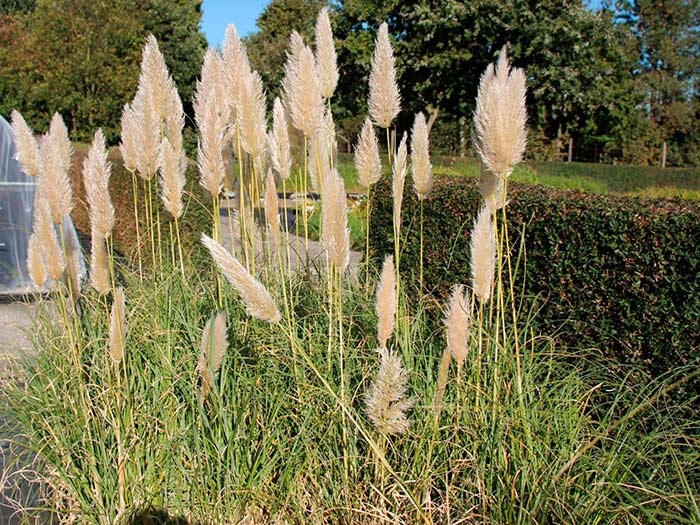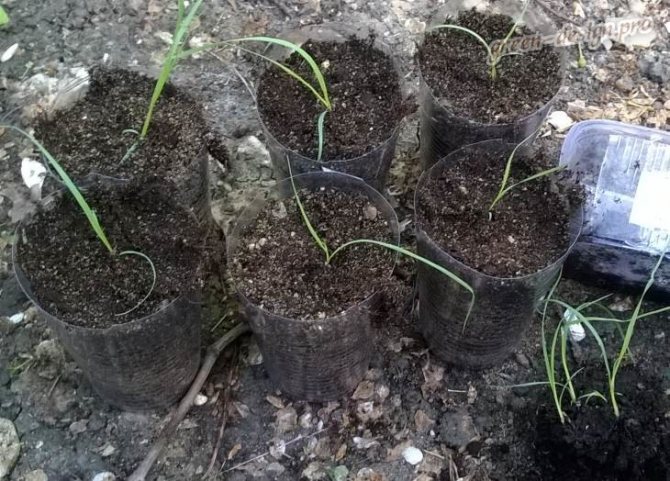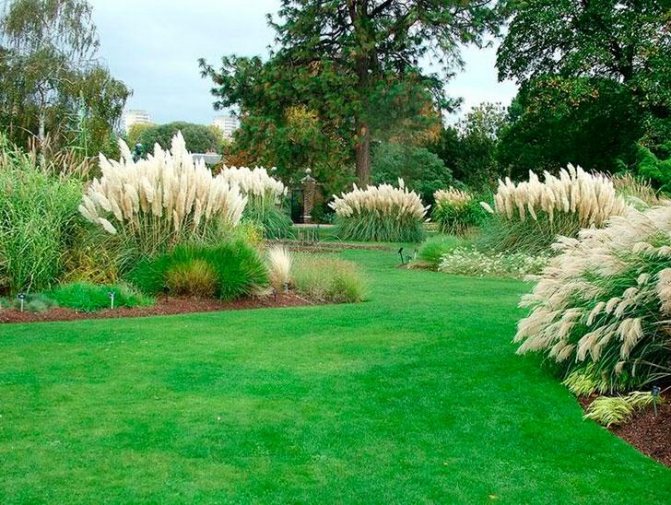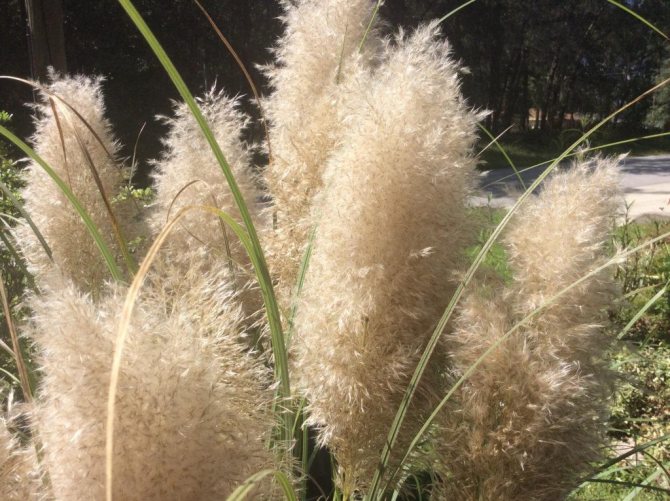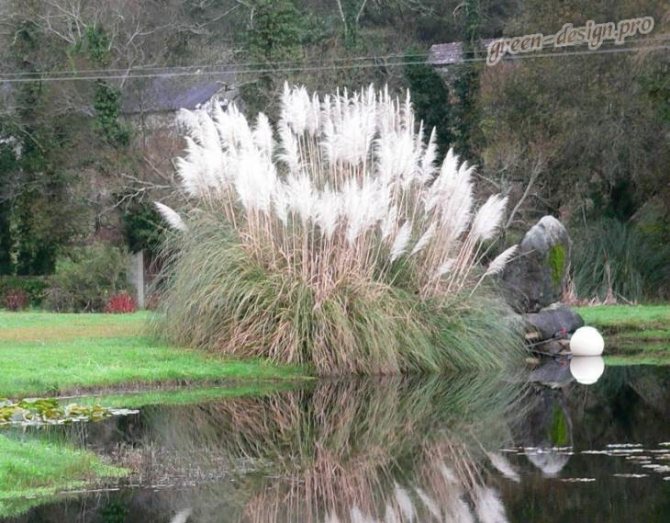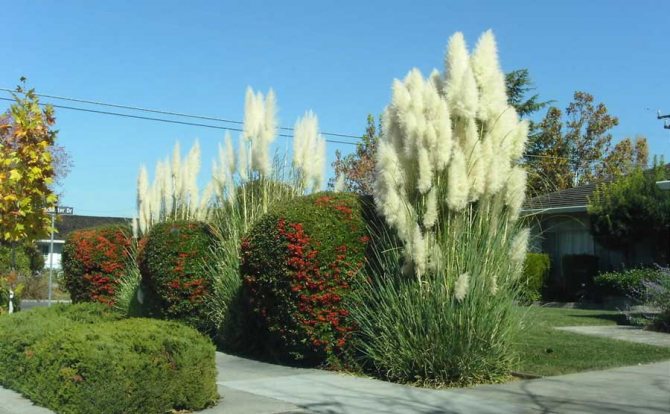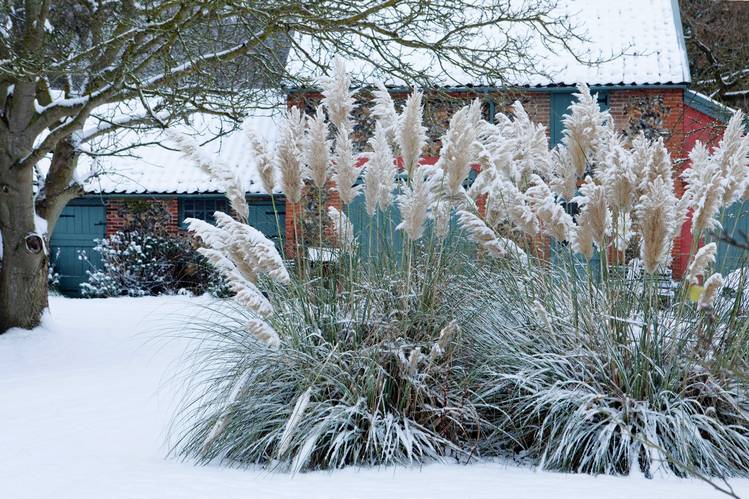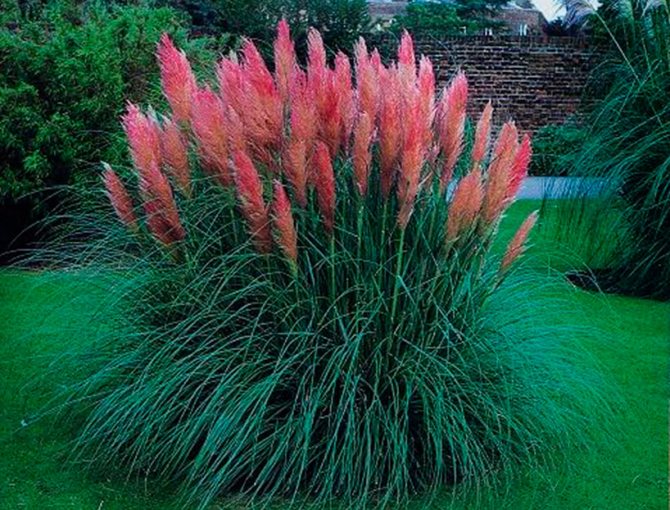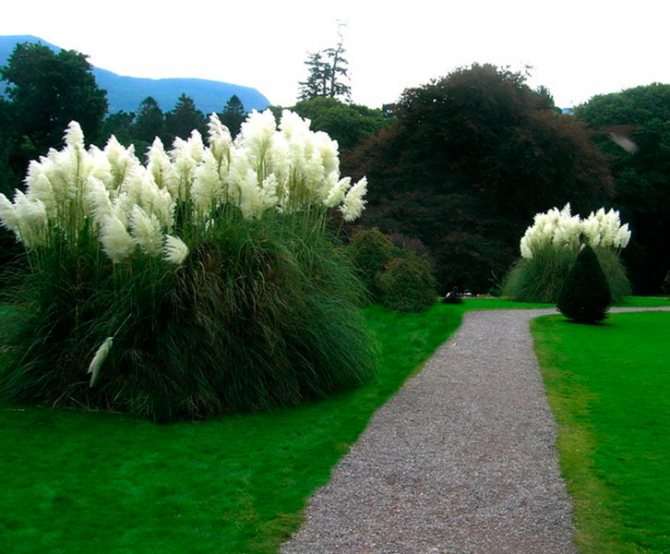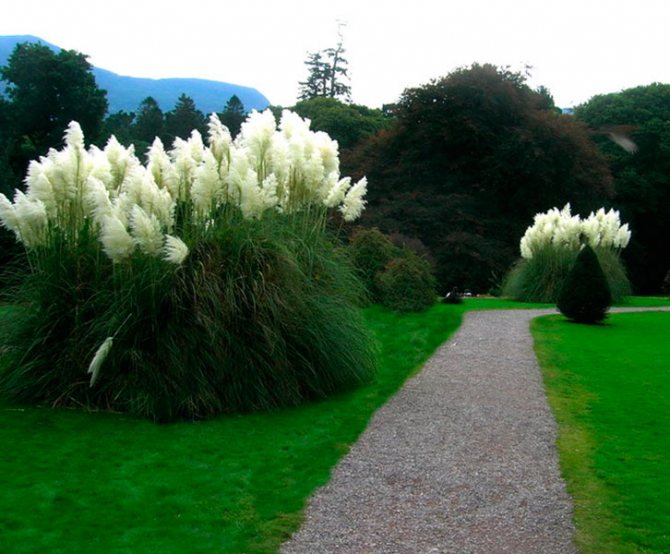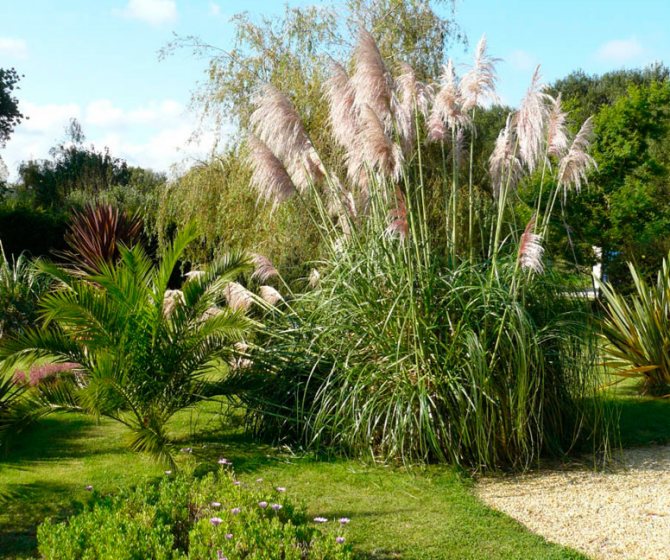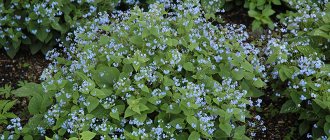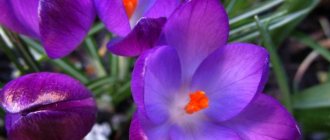If the soil in your area is not suitable for capricious ornamental plants, do not despair. A spectacular and hardy silver cortaderia will help to decorate the garden, planting and caring for it will help even the most inexperienced gardener realize the dream of an unusual flower garden.
Cortaderia (pampas grass) belongs to the bluegrass family, it is native to South America. This is an amazing plant, beautiful and absolutely unpretentious. For all species, and there are about 23 of them, the type of soil, the shade of the site or the depth of the groundwater does not matter at all.
Gardeners are especially fond of the pink and silver cortaderia. She quickly adapts to habitat conditions and will survive even in the driest conditions. If you treat it with attention and care, then the cereal perennial will look just amazing. Thin straight peduncles with a graceful bend will reach three meters in length, exquisite panicles of inflorescences of small silvery spikelets will form at the end, and lanceolate leaves form a fluffy bush. It is difficult not to pay attention to such beauty, especially since the plant retains its decorative effect for a very long time and over time can grow into dense plantations.
Queen of herbs
Cortaderia selloana of the family of cereals is considered one of the most beautiful ornamental garden plants with characteristic, usually white or cream-colored inflorescences - panicles. The most original inflorescences in varieties are pink. Cortaderia inflorescences can be up to 1 meter long and are sometimes called fox's tail.
The perennial owes its popular name to its natural habitat. The term "pampas" comes from the pampas, or steppe grassy steppes in South America, where cattle graze, typical of some regions of Argentina, Brazil, Chile. The soil there is fertile, permeable, rich in calcium. Bushes reach a height of 2.5-3 meters, grow widely.
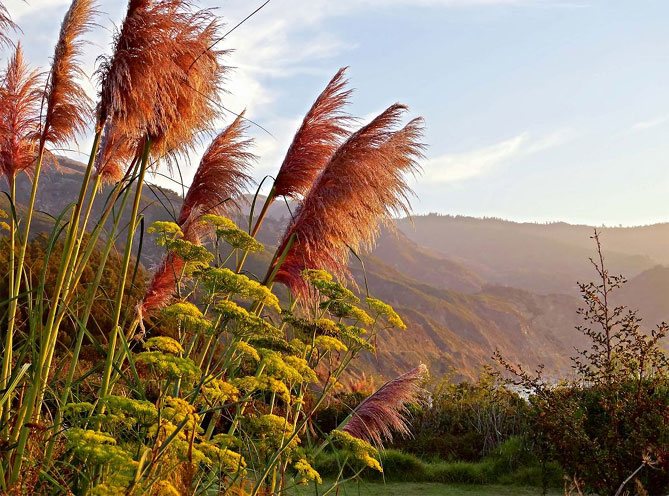
The great advantage of the plant is that from spring to August it acts as an excellent background element. Leaves can fill a square meter of surface, are compact, usually have a pure blue-green color. The plant then gives flowers and plays the role of a soloist in the garden.
Cortaderia blooms at the turn of September and October, large inflorescences adorn the bushes all winter, especially when they are silvered with hoarfrost. During the flowering period, the plant reaches a height of 3 meters. The tallest, thickest and most fluffy female panicles. Inflorescences are found in white, cream colors, and in breeding varieties - pink, pink-purple, silvery. You can admire them in September-October. Unfortunately, in our climatic conditions, you can enjoy inflorescences when the summer is long, sunny, warm.
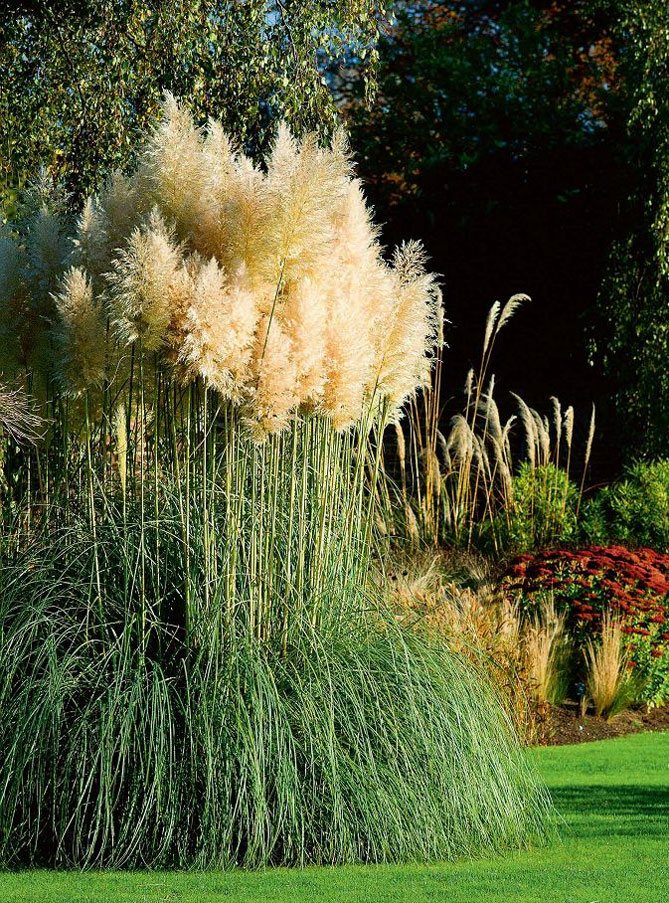

Cortaderia belongs to dioecious plants - male and female flowers appear on different plants.
The leaves of the cortaderia are long, reaching 1 meter. They lean towards the ground, forming picturesque dense clusters. A bush 3-4 years old can have a height of 2 meters. There are also varieties of grass with striped leaves, such as cool ice.
During cultivation, the grass does not cause any problems, difficulties arise during the wintering period.
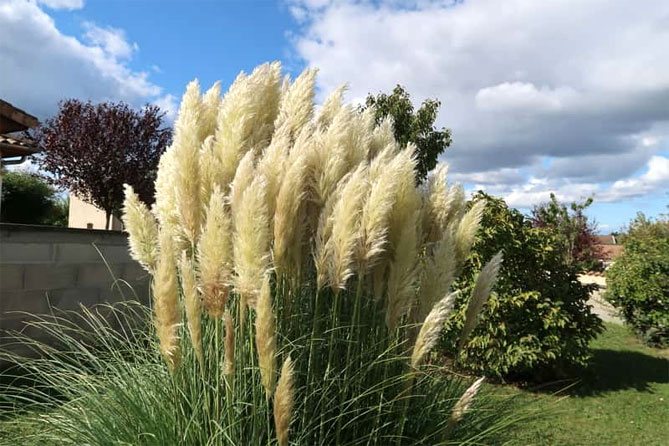

Wintering Pampas Grass, Pest Control and Role in Landscape Projects
Cortaderia easily tolerates both drought and an abundance of moisture, which is its advantage. It owes such properties to a strong and extensive root system, which penetrates 4-7 meters into the soil layers, reaching the groundwater and providing itself with adequate nutrition and moisture. Abundant watering promotes the growth of the grass, but even during a drought, during a period of complete lack of moisture, it will not disappear. The culture has relatively good frost resistance, but it still needs to be prepared for severe frosts, otherwise it will simply freeze out. To ensure normal wintering, all the free space around the shrub is fenced off and a thermal insulation layer is created, covering it with hay, foliage, etc. To avoid such hassles, many gardeners prefer to grow cortaderia in voluminous flowerpots for reasons of practicality. With the onset of frost, the plant, along with the flowerpot, easily moves inside the room, and with the first spring rays of the sun, it is exposed to the street.


The plant has excellent resistance to various kinds of parasites and pests. With the right approach to the care of the cortaderia, it practically does not lend itself to the influence of insects and diseases of a fungal nature.
At the same time, in a favorable environment, the bush can grow significantly, therefore, to give it shape and correct lines, periodic pruning is required. This should be done with great care, performing work in protective gloves and tight clothing. This categorization is due to the fact that this type of grass has rather sharp leaves, which can easily hurt.
The outward curiosity of this bush makes it possible to use the plant to create unforgettable landscape styles, the attractiveness and versatility of which will not leave indifferent any connoisseur of flora.
Varieties
Cortaderia has won a loyal following and is found in numerous varieties, differing in size, color, resistance to freezing temperatures. Due to the low frost resistance of the grass, many varieties are not suitable for wintering in the open field. It is necessary to choose varieties that are characterized by high frost resistance.
In our gardens, the most common type of Cortaderia selloana - the bush has green leaves, light inflorescences, grows up to 2-3 meters in height.
The following varieties are popular.
- The widespread variety "Remorino", the height of the shoots reaches 2.5 meters, the plants are resistant to our conditions. Remorino is a tall herb with long silvery buds.
- The varieties are characterized by silvery panicles 1 meter long:
- "Pumila" (pumila) - compact form, relatively low height - 1 meter, creamy white fluffy panicles, the most frost-resistant variety;
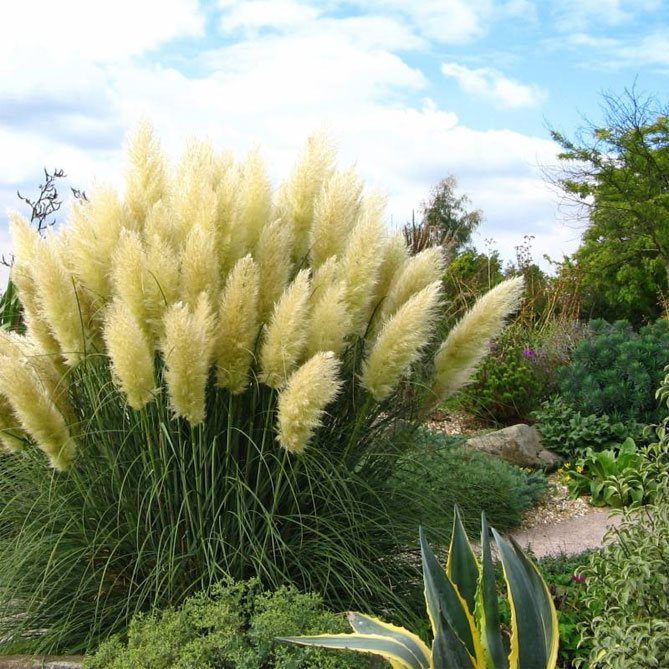

- "Elegans" (elegans);
- "Argentia" (argentea) - a silvery-white inflorescence.
- "Sunnigdale Silver" - large, silvery-white inflorescences, grows up to 2.5 meters.
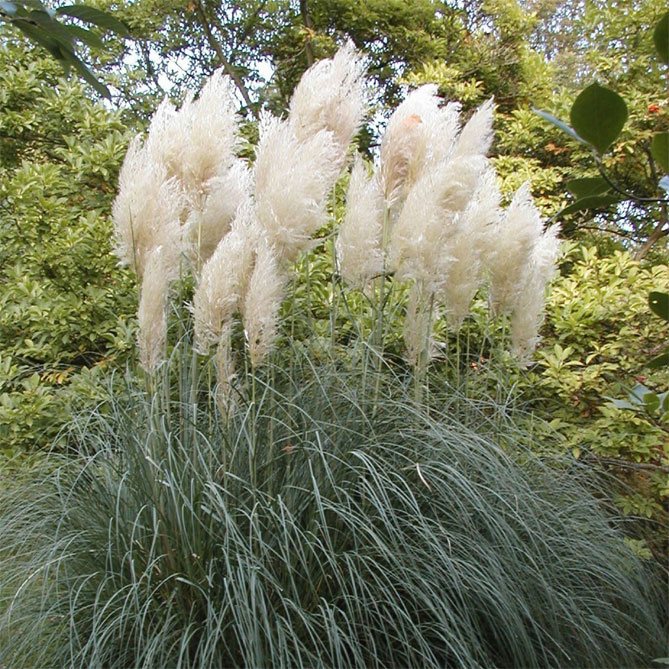

- Pink grass is very specific, popular varieties:
- "Rosea" (Rosea) - creates impressive panicles of silver-pink color, blooms in late September, grows up to 2 meters;
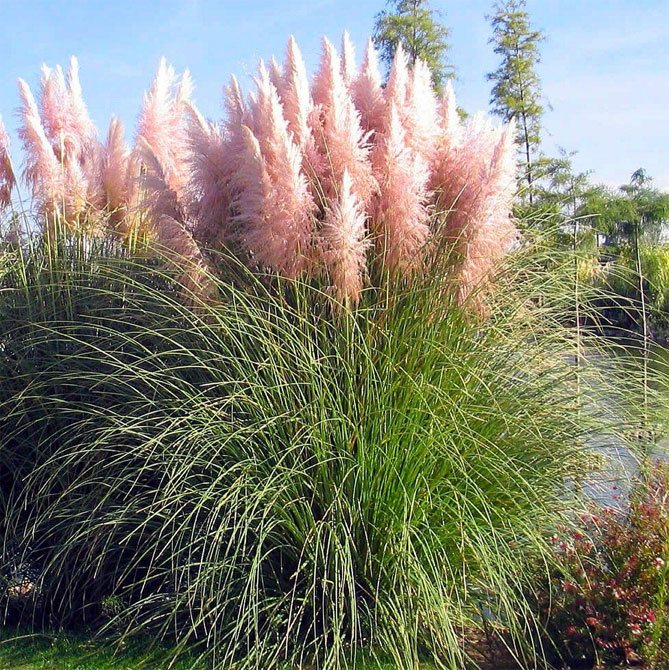

- "Pink Feza" (Pink feather);
- "Rendatler" (Rendatleri) - with brown-pink panicles, resembles wild grass, shoots 2 meters high.
- Cool ice is a variety with striking striped leaves.
- "Gigantea" (Gigantea) - the height in optimal conditions can exceed 3 meters.
- Andes Silver - creates tall, creamy panicles.
- "Silver Comet" (Silver Comet) - a very original variety with silvery striped, narrow leaves.
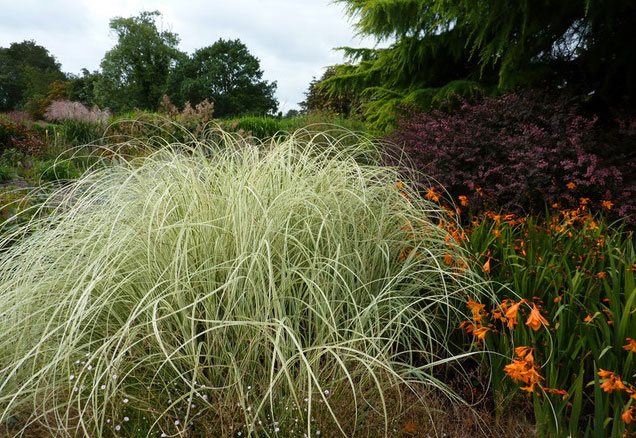

- "Splendid Star" - golden yellow leaves (height reaches 1 meter during the flowering period).
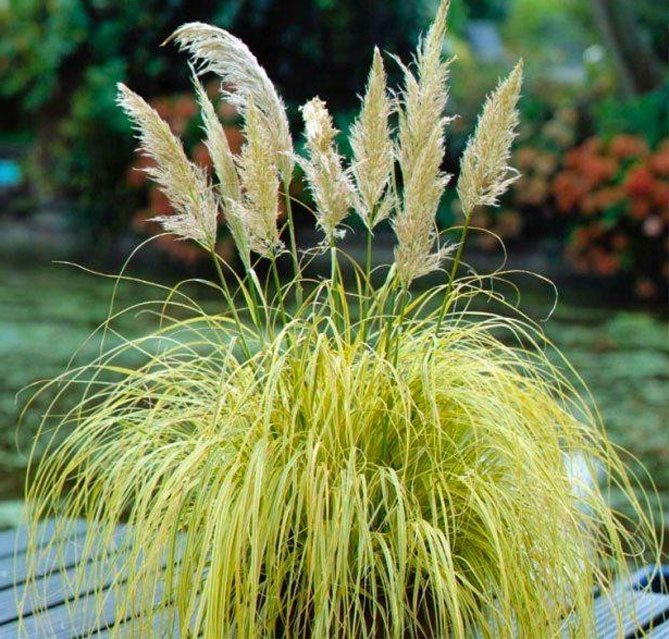

- "White" - a variety with white, beautifully presented flowers.
- Albolineata - leaves with white edges.
- "Aureolinata" (Aureolineata) - yellow edges of the leaves.
- "Evita" is a low grade, reaching a height of 75 cm.
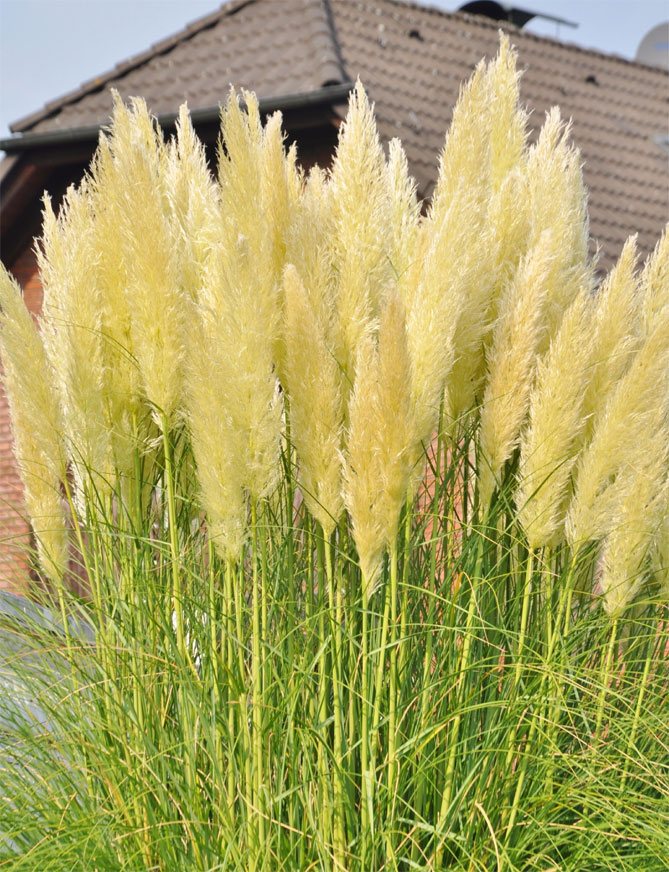

- "Patagonia" (Patagonia) - medium-sized variety, light green leaves, flower panicles of light or reddish color.
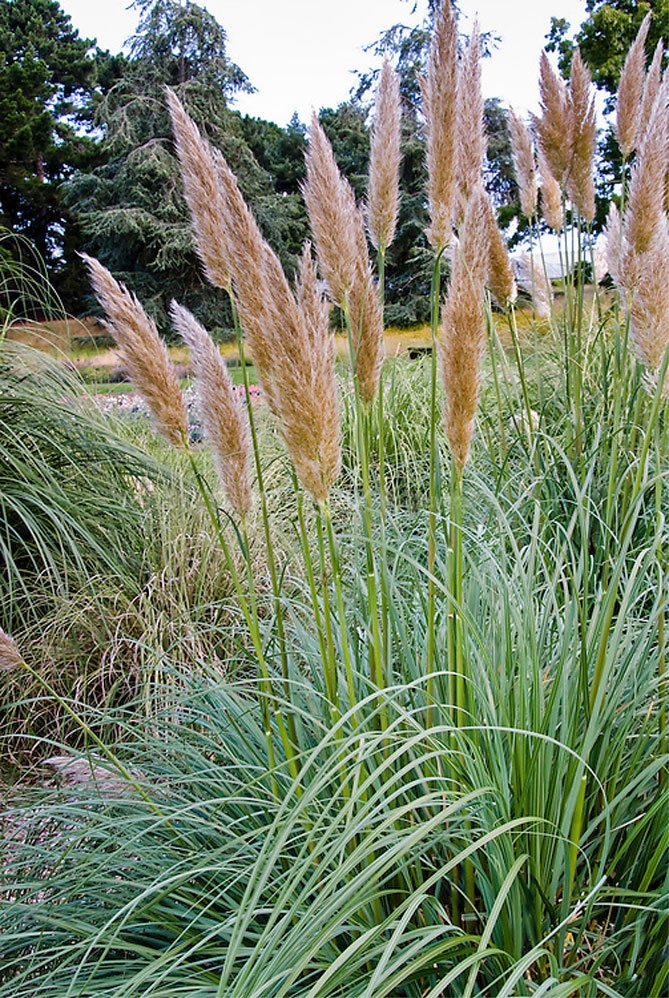

In warm countries, you can grow grass varieties with inflorescences in various interesting colors (pink, white). In our climate, these varieties do not have a chance to spend the winter, and if they succeed, flowering is rare. Therefore, it is worth choosing frost-resistant varieties.
The most frost-resistant variety in our climatic conditions is "Pumila" with cream-colored inflorescences.


It is worth noting the frost-resistant undersized variety "Splendid Star", 1 meter high, with white striped leaves.
Species diversity of cortaderia
The species diversity of the plant is small; among the cultivated varieties of pampas grass, several can be distinguished:


cortaderia variety - Sunningdale Silver
- Albolineata - relatively low (2 m) plant, characterized by variegated foliage with yellowish tips;
- Sunningdale silver - four-meter grass, with voluminous, dense inflorescences;
- Patagonia - grass two meters high, with gray-green foliage. Inflorescences are white-silvery. Relatively resistant to frost.
Reproduction of cortaderia
Pampas grass propagates in the following ways:
- generatively - by seeds;
- vegetatively - by dividing the bush or cuttings.
Reproduction by division
Cortaderia is a dioecious plant. Women's flowers look the most impressive. Male inflorescences look much less impressive, as if they are wet, stuck together. Therefore, it is preferable to propagate the cortaderia by dividing the female plants. Then there is confidence that the resulting seedlings will repeat the characteristics of the mother plant.
The best time for dividing the bush is May-June, although some sources say early spring, before the beginning of the growing season. The rhizome is dug up and divided into several parts. By propagating a bush of grass that has already produced inflorescences, you can be sure that the separated plants will bloom as well. Plants with a large root system will grow better and bloom next year.
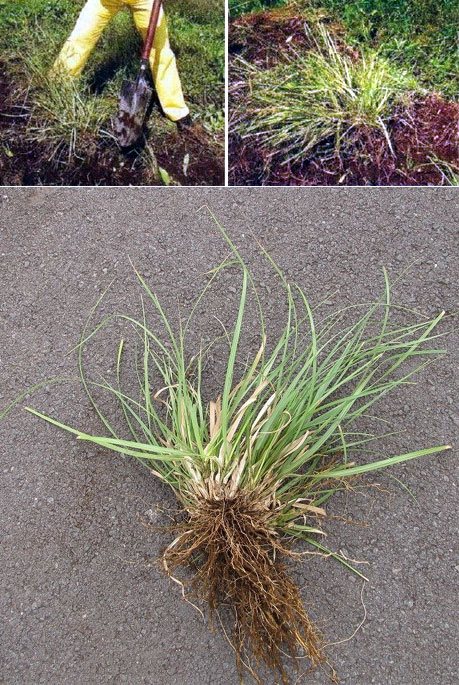

The grass is most often planted when the first true spring days (May) come, it is preferable to choose a sunny day. In March-April, it is necessary to remove frozen, dead leaves after winter. The plant will quickly begin to release new shoots.
Propagation by cuttings
You can try growing grass from cuttings taken from old bushes in late summer. Cut off shoots several centimeters long. The lower part is dipped in a rooting machine and planted in the ground.
Seed planting
When growing pampas grass from seeds, you need to take into account:
- half of the seedlings will produce less showy male flowers;
- seedlings obtained from seeds will not always bloom;
- flowering usually occurs after 3-4 years.
In our climate, the plant does not set seeds, so it is impossible to collect them on your own.
Seeds of pampas grass are sown early, you can start sowing from February (preferably in March) in boxes. Since the seeds are very small, it is worth mixing them with sand and then covering with sand. Young plants germinate in 2-3 weeks at room temperature (20-22 ºC).


Such seedlings subsequently require picking into large containers with a diameter of 8-10 cm. In the summer they are placed outside. Saplings grow very quickly, but in the first year it is better for them to spend the winter in an unheated, but well-insulated greenhouse.
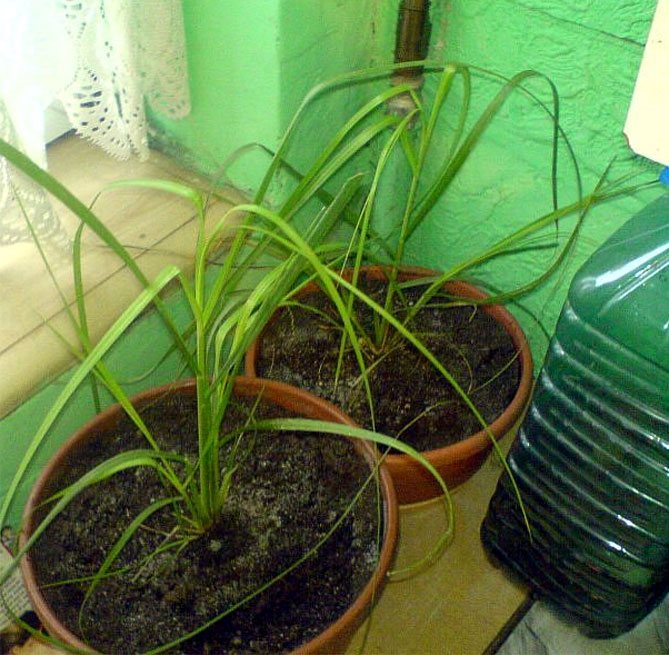

Cortaderia is a dioecious plant, so at least 2 plants of different sexes are needed to form seeds - this is important for people planning to harvest seeds from their plants.
What plants are combined with pampas grass, diseases and pests of cortaderia
Like many cereals, cortaderia is resistant to disease and is also rarely affected by any insects.
When planting a decorative cereal in your area, you should remember about the unpleasant properties of its stems.It is not recommended to use the cortaderia near pedestrian paths and near the entrance of the house. The long, sharp leaves can easily get tangled and cut into your hands. This is especially true for families with small children.
Large plants like cortaderia are well suited for the background of prefabricated flower beds. If there is an artificial pond on the site, you can plant the crop along the shore. The inflorescences will be beautifully reflected on the water surface. Layered stones of different shapes will add to the effect. Here, on moderately moist soils, the company of the cortaderia can be:
- valerian;
- willow loosestrife;
- sugar-colored miscanthus;
- meadowsweet Kamchatka;
- delphinium hybrid.
Some gardeners grow pampas grass as a hedge, its dense thickets will hide the area from prying eyes.


Pampas grass in landscape design
Cortaderia is also combined with other tall crops: elecampane high, gypsophila paniculata, heart-leaved katran, small astrantia, beautiful telekiya. These plants, like cortaderia, are drought-resistant, so the whole composition does not require special care.
Pampas grass is also used for single planting. In large areas with poor soil, the cereal grows successfully and blooms profusely until autumn.
In more fertile areas, the cortaderia is also combined with the usual garden flowers: dahlias, asters, rudbeckia. The main thing is that the plants do not interfere with each other, they are combined in color and size.
Cortaderia growing like in the photo is not so often seen in the courtyards of houses, this decorative cereal is quite exotic. By planting pampas grass on the site, you will undoubtedly delight yourself and surprise your neighbors.
Landing
Young plants are best planted in a permeable substrate; a humus mixture of peat and sand is optimal.
Landing requirements
Pampas ornamental grass likes places that are fully sunlit, sheltered from the wind, and its long leaves are quite fragile. The planting site can be chosen surrounded by tall conifers or under a wall with a southwest or south exposure.


You can not plant grass in pits, depressions of the soil, where water stagnates!
The most suitable time for planting is late spring, because the plant requires warmth for growth, in addition, in the initial period, the bush is especially sensitive to cold. Therefore, planting is usually carried out in May, after the last frost.
Attention! The temperature for growing cortaderia should not fall below -17 ° C.
Preparing the soil for planting
A permeable, fertile soil similar to pampas is required. If the grass is planted in the shade, it will most likely not bloom. On heavy clay soil, the cortaderia quickly disappears. The soil should be moderately moist, rich in calcium. Under no circumstances should the soil be too wet. Excess water causes the grass to rot and die. For this reason, grass is not planted near water, for example, near a pond at the bottom of a slope. The top layer of soil is mixed with coarse sand and gravel, and a lot of compost is added to the deeper layer.
Depending on the soil conditions in the garden, the way the soil is prepared differs.
How to plant grass in permeable and sandy soils
Growing grass on permeable and sandy soils, dig a hole to the permeable soil layer and fill it with a mixture composed in the following proportions:


The prepared soil is filled with a hole and a small embankment is created, which will divert excess water to the sides during snowmelt or heavy rains.
Planting in heavy clay soils
If the grass will be planted on soils with impermeable layers, clayey (a symptom is a longer stagnation of water, for example, after rainstorms), drainage must be performed at the bottom of the pit. The thickness of the drainage layer is at least 20 cm, the composition is coarse gravel or small pebbles.Drainage in the case of heavy and clayey soils is necessary to remove excess water, which exposes plant roots to rot. The soil is compiled without using native soil, if clay prevails in it. Instead, you can increase the proportions of peat, compost and sand. In this case, the mixture should contain about 30% sand.
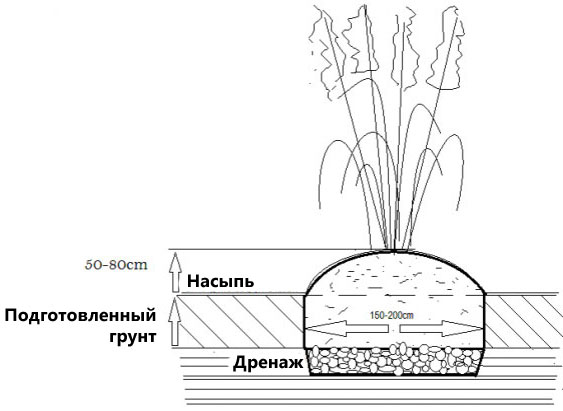

Planting, care and cultivation of pampas grass
Cortaderia, being a weed, is absolutely unpretentious and can grow almost everywhere. Her indifference to increased acidity or, conversely, freshness of the soil only plays into the hands. Based on this, Pampas grass, which can be planted regardless of natural conditions, can decorate even the poorest lands. It grows quite easily in clay soil and is able to survive even on rocks, quickly filling the remains of loose rocky soil. The only factor that the plant reacts to is sunlight: the more sun, the more abundantly the grass begins to grow, occupying more and more territory.
Planting and caring for the Pampas grass cortaderia has a rather specific format. Before sowing seeds of pampas grass, you need to prepare by choosing the optimal place and time for planting. As practice shows, the most successful period for the implementation of the plan is the beginning or middle of spring. It is best to sow pampas grass seeds immediately after the snow melts and the frost has receded. Showing excellent germination and good adaptive qualities, grains still remain an excellent delicacy for various kinds of rodents and beetles, which are actively searching for food during this period. Therefore, immediately before sowing, the seeds must be treated with some kind of protective agent or simply dipped in a solution of potassium permanganate.
Breeding and reproduction of cortaderia does not take much time and effort. Showing excellent survivability and the ability to adapt to the harshest conditions, it grows and develops rapidly. It is enough just to place the seed in a container or pot of soil, cover it with a lid and put it in a warm place. After 15-20 days, the seeds will sprout, and soon the first shoots can be observed. It is impossible to keep the culture in this position for a long time, because soon its roots will no longer fit into the pot. Therefore, 5-10 days after the emergence of the sprouts, open ground should be planted, in which they will continue their development, strengthen the structure and become a full-fledged plant.
Growing
Pampas grass, as befits a queen, is demanding. It is important to know how to properly grow and care for a plant. Growing requires a lot of procedures, the bush loves the sun and well-permeable soil, and long preparations are required for wintering.
The grass is negatively affected by:
- cold winds
- excess moisture
- severe frost.
Therefore, growing grass requires many protective measures.
Attention! The edge of the leaf blade is covered with tiny, sharp teeth - it is easy to cut the skin with the leaves. Thick gloves are required for work.
Watering
The cortaderia grass needs regular watering during the growing season. It is especially important to remember about irrigation during a drought. You need to water the plant, trying not to wet the leaves with water. It is necessary to ensure that there is no stagnation of water from watering, this leads to inhibition of flowering and even to the death of the plant. For these reasons, growing grass is quite difficult.
In rainy weather, in the cold season, it is advisable to equip a waterproof roof so that the soil under the plant dries out.
Fertilizer
It is important to systematically feed the cortaderia with nutrients rich in nitrogen, which will accelerate growth and flowering.
Organic fertilizers are best suited - compost, which is spread out in a thin layer every year before the beginning of the growing season. It is advisable to regularly feed the plant before flowering, but it is important not to overdo it because over fertilization interferes with normal growth.
Usually the grass is fed twice:
- the first feeding - in May;
- the second in July.
The complex fertilizer must be dissolved in water and the seedlings must be watered. In the spring, you can feed the grass with Azofoska every 3-4 weeks.
Wintering
Cortaderia in our climate often freezes, especially young seedlings. Overwintering pampas grass requires special protective measures. The best way is to tie the top shoots into a sheaf. It is best to hold the event when the grass starts to turn yellow. It is advisable to pre-cut the grass to a height of 30-40 cm. Sheaves of bound grass of bizarre shapes will give a charming look to the winter garden. The grass will then be safe and very decorative. It can scare off four-legged intruders who gnaw the bark of trees in winter.
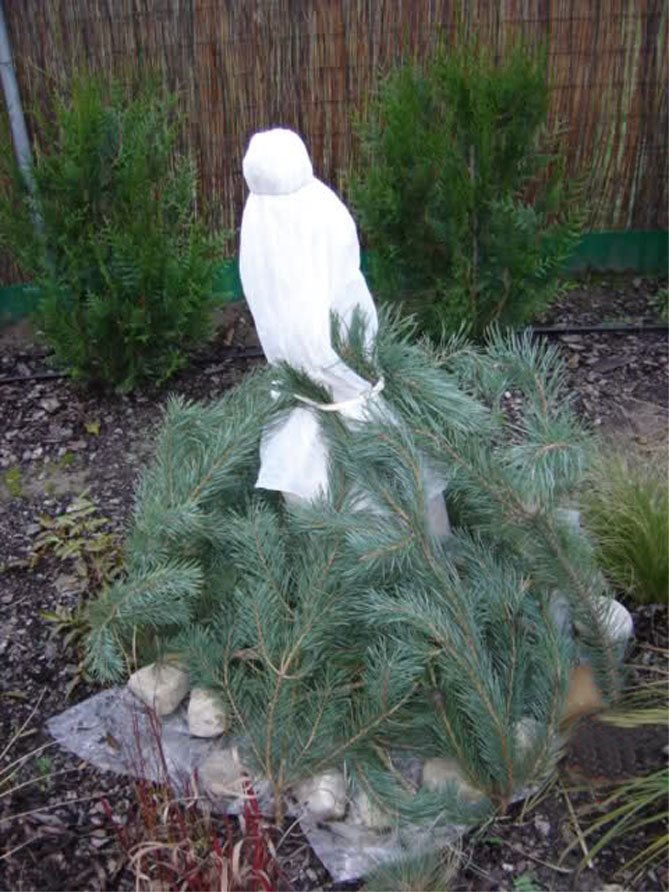

In order for the water to flow down the top of the sheaves, you need to tie all the leaves of the grass. It is also worth tying the bundles in several places, forming a tent-shaped bundle. You can throw a jute bag without a bottom over the plant, which is additionally filled with leaves. The leaves are harvested in the fall, dried in a dry, well-ventilated place so that they do not rot or rot. It is important that the leaves are dry and light when covered. Around the plant within a radius of 1 meter, the soil should be covered with a layer of dry leaves with a layer of up to 40 cm, sprinkling them with earth. In the spring, the leaves are removed. This is the best way to keep your grass overwintered.


To prevent water from getting into the mulch, it should be covered with foil.


In cold regions, for example, in the Moscow region, it is recommended to cover the plant additionally with straw or agrotextile and even make a roof over the bush. In this state, the grass hibernates without watering.
In regions such as Siberia, the Urals, the cultivation of a cortaderia is very burdensome. Since, in addition to protection from frost, the grass loves long daylight hours.
The grass can be transplanted into a pot and moved to a safe place for the winter. For this it is worth choosing the undersized variety "Pumila" (Pumila). In winter, the plant is stored in bright rooms with temperatures up to 10 degrees Celsius. In early spring, the bush is taken out to the balcony, terrace, cutting off last year's leaves, inflorescences. The same is done with the cortaderia planted in the garden. However, the grass does not tolerate such an annual excavation, its root system is easily damaged. Therefore, the more recommended wintering method is planting in a large pot, which is easy to carry and store in a cool and bright room during the winter.
Diseases and pests
Uncut, old grass can become a habitat for insects (even wasps). In general, the plant practically does not get sick. The main thing is to avoid excess moisture, which causes damping and rot.
Plant content
Caring for pampas grass is not difficult at all. Any soil is suitable, fertile or not, it does not matter for the cortaderia: it multiplies and blooms on any of the soils. Drought-resistant plant, tolerates areas of sunlight well all day. They are planted in spacious areas, it is possible even in those where other crops do not grow - the cortaderia will grow!
If there is no precipitation for a long time, then you need to water it with water, preferably twice a month. Top dressing is applied only at the beginning of the growing season. You can apply both organic and mineral fertilizers.
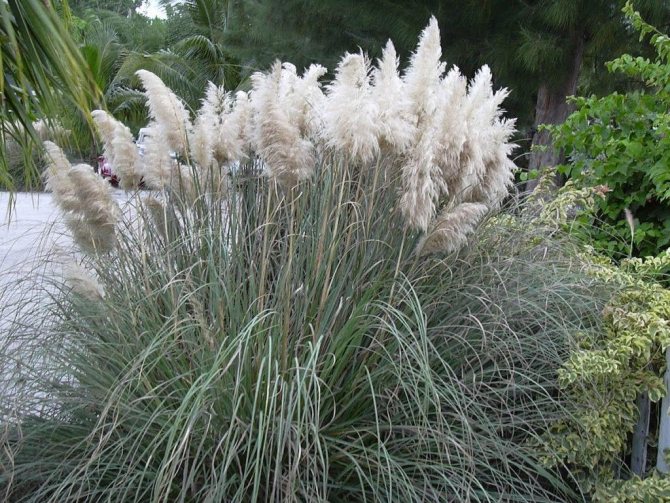

Such a tall plant needs to be prepared for winter. To do this, cut off all the shoots, leaving a height of 50-70 cm. Tie them all together, slightly tilt them to the soil. Insulation materials are applied near the base of the connected bundle: dry leaves, spruce branches, straw or peat.
This plant is not predisposed to any diseases, harmful insects bypass the cortaderia.
Group landings look very impressive. Can be dropped off in the background. Only when planting is it necessary to take into account the aggressiveness of the roots: after a short period of time, the cortaderia can displace other crops. You need to know this when selecting neighbors for a flower bed.


You can calmly plant only a group of these plants themselves, you can plant several varieties together, their multi-colored spikelets will decorate the site. The panicles are cut for winter bouquets, which will last almost until spring.
Application in landscape design
The beauty of the flowers and leaves makes the grass look better like a tapeworm (planted alone), but it can be arranged in a naturalistic composition with other perennials, and even in the form of a hedge.
The grass looks very attractive in compositions with plants that change the color of the foliage in the fall. It is worth planting her in the company:
- maple,
- elms,
- birch,
- and you.
In the autumn key, the cortaderia plays great with the following ornamental plants:
- spirea,
- fieldfare,
- Rowan,
- viburnum,
- girlish grapes,
- irga,
- euonymus.
The cortaderia is beautifully presented against the backdrop of dark hedges, over the pond and wherever garden architecture allows you to relax and unwind among the delicate rustle of grass.
With a very distinctive and unique appearance, the grass will become an attractive backdrop for flowers and shrubs. Stems of grass, dancing in the wind, are beautifully intertwined, creating the impression of a dynamic pictorial picture, especially when combined with flowering perennials:
- bells
- monard,
- sage
- heycheroi,
- cloves
- asters,
- yarrow,
- lavender,
- irises,
- daylilies.
Ornamental grass in combination with more muted plants gives a feeling of calmness, looks beautiful in the company of plants in shades of purple. A great addition would be:
- hydrangea,
- boxwood,
- rose flower,
- dogwood,
- Buddley of David.
The romantic charm of the grass is emphasized by the company of birches.
The herb is also ideal for dry bouquets. The best time to cut and dry fluffy pampas panicles is when the flowers are not fully developed.
In the past, herbs were little used in garden design. Now they are a very attractive element of garden plantings. The pampas grass is special in this respect, it is distinguished by its large and unusually decorative inflorescences. This makes it suitable for modern futuristic gardens. The plant is a little capricious, it requires special wintering conditions, but its extraordinary inflorescences will generously thank the caring gardener for their work.
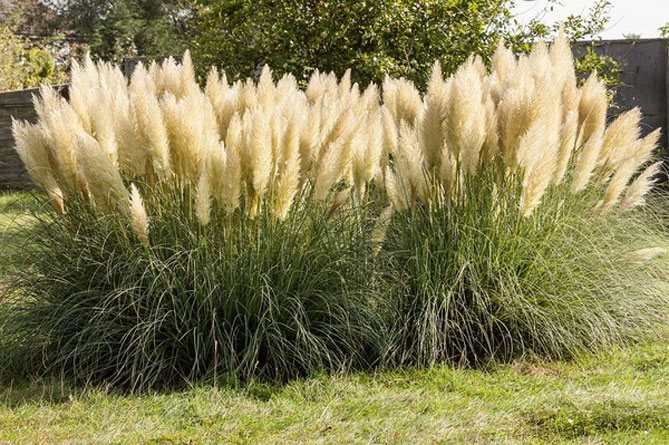

Using pampas grass
Due to its unusual appearance, it is used in European countries as an interesting decorative element of landscape design.


The grass will be a good decoration for the lawn, garden paths, looks good in single plantings.
The flowers of the plant are also widely used as elements of exotic bouquets. Cortaderia or pampas grass would be an excellent option for decorating a summer cottage
Application of pampas grass in the garden
Pampas grass in the garden is most beautiful as a standalone plant on the lawn, but can also be an excellent backdrop for flower arrangements, which are the highest section of the flower bed. The plant looks beautiful, also near the resting place, where its large leaves and large flowers provide shelter and protect from the wind. The inflorescences are suitable for cutting and drying.
Here is what the court looks like in the gardens, photo:
Cortaderia pink:
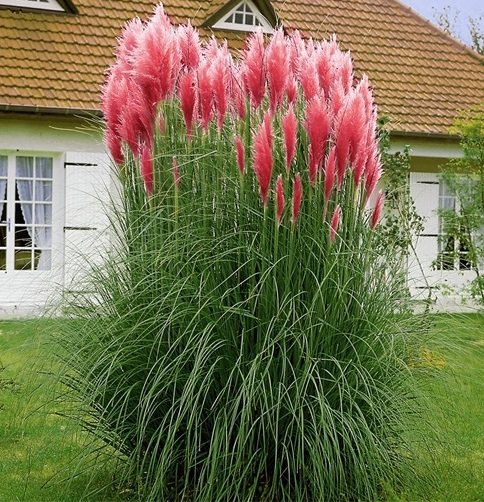

Preparing for winter
The grass does not tolerate a strong drop in temperature with high humidity and soil. In order for the plant to overwinter safely, a dry shelter of sawdust, dry leaves, and covering material should be provided.
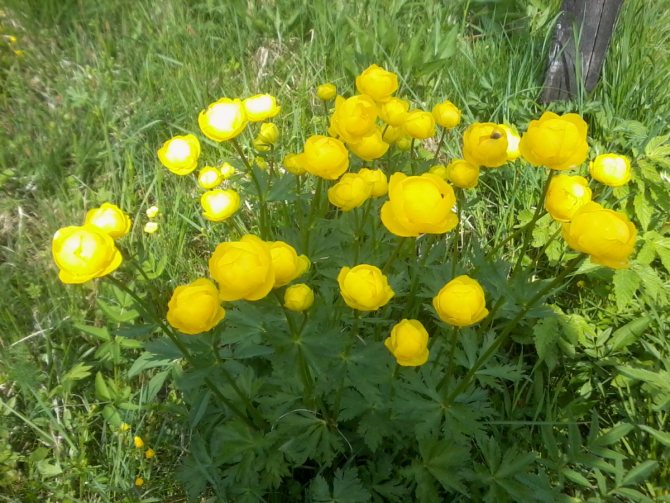

Before covering the plant, it should be shortened by half a meter, tie with a rope and bend to the ground. Then the bushes are sprinkled with material that does not allow moisture to pass through well. For this purpose, you can use straw. From above the planting is covered with burlap, you can put on a box or a wooden barrel on top. Such a shelter must necessarily close the root system.
It is very important to choose the right time to cover the plant. Additional protection should be provided if the air temperature drops to -10 degrees.
Cortaderia widely used in garden design... The shrub is used to decorate flower beds and lawns. The plant can give an attractive appearance to an empty area. Cortaderia can be planted along stone structures.
Description of the plant
Pampas grass is a perennial herb of the Cereals family that forms dense and wide sods. The plant is widespread in the Argentine pampas.
The herb gets its name from the appearance of the leaves, which have a sharp cutting edge. The height of the stems can reach three or more meters. A close relative of the pampas herb is the muli herb.
Leaves are thin, long, drooping. The leaf surface can be painted green or bluish. At the tops are lush inflorescences up to half a meter long. An adult bush has a rounded shape. Inflorescences have the shape of a panicle, the color of the flowers can be varied: silvery, yellow, pink or striped. Cortaderia flowers are dioecious. Female flowers are more decorative and attractive. The flowering period lasts from August to the end of November.
Danger at the summer cottage
If this South American aborigine grows on your site, then you need to know how to work with it. Cortaderia translated from Spanish cortar means "to cut". Sharp edge of the leaf can severely injure human skin.
Do not plant it at the edge of garden paths, near benches and children's lawns. To avoid cuts, work should be done with gloves and long-sleeved clothing.
In large bushes of pampas grass, hedgehogs often retire for hibernation. When carrying out spring pruning, do not lose vigilance when trimming dry leaves in the root zone.
Testimonials
When I first saw the Pampas grass in Yalta, I really wanted to plant it, but I was afraid to grow it in the ground. I planted it in a large pot of 12 liters. For the winter I transfer it to the veranda, where the average temperature is about 5 degrees. It grows well, blooms in summer, does not get sick. I really like!
I sowed the seeds in March, the seedlings were thin, I thought they would not survive, I did not dive, then I transplanted them into a pot and the pampaska started growing. Now the beautiful one is standing. In our climate, it can only be grown in pots, before the frosts I put it in the basement, I have it big and put it by the window.
In the suburbs, my cortaderia did not winter - it froze. Despite the fact that I covered her with leaves. She is afraid of both frost and damping, a dry winter is needed! You need to tie it into sheaves, make a roof on top. Maybe I chose the wrong variety, I don't remember the name anymore.
There are several types of Pampas grass, or cortaderia. Of these, the most frost-resistant c. Sello (Cortaderia selloana). Its varieties are even more frost-resistant: 'Andes Silver', 'Patagonia', 'Pumila', which withstand -18 degrees C. she is warm and comfortable (they still cover her for the winter). It grows in one place for many years, growing into a "nest" that needs to be divided.
Characteristics of the cortaderia
The pampas grass belongs to the Bluegrass (Cereals) family. Herbaceous plant 3 meters high with evergreen rough lanceolate leaves. Forming a bush, it throws out beautiful inflorescences from small spikelets of the most delicate shades. Plant the adaptation period goes unpretentious and well.
Very hardy and species composition of the soil does not affect its growth in any way. The South American weed has easily adapted to our latitudes and has become an amazing ornamental plant.
Like all cereals, pampas grass gives a good harvest of seeds... Due to this ability, the sale of seeds is prohibited in the homeland. It is difficult to control a weed whose roots do not die during the burning process.


Pampas grass fields
Dwelling in the pampas (steppes) of South America, the grass is the most beautiful representative of cereals.
Cortaderia has an unpleasant feature - it is considered poisonous before the seeds ripen. After the ripening period, it is safe and harmless.
An overseas guest looks great in creating a landscape, goes well with her relatives. The more sunlight it receives, the more and wider the bush will form. Flowering occurs in August-November.
Spread
Pampas grass can grow in any type of soil. However, cortaderia grows well in clay soil with a lot of stones and sand. In its natural habitat, pampas grass grows in acidic soil. It grows in fields or meadows, in open parks, away from swampy areas.
Cortaderia is grown for decorative use only. Pampas grass is unpretentious, so you can meet a perennial in any climatic conditions. Since ancient times, the plant has been cultivated in North America, western regions of Europe. Certain species can be found in Australia. In addition, pampas grass is grown in many gardens and parks in Russia.
The natural habitat of the plant is rather scarce - the cortaderia, as an independent shrub, can be seen only in the southern regions of America. However, even there, a beautiful flower is considered a weed, destroying a perennial or processing it for domestic use.
Planting from seeds and caring for pampas grass
Breeds using seeds and vegetatively parts of the formed rhizome.
Seeds have good germination, but the only problem with this method of reproduction is the stage of stratification.
The acceleration of germination is associated with low temperatures, under the influence of which the seed coat is destroyed.
Propagating pampas grass in this way, it will be possible to admire the flowering of the plant only after 5 years. It is better to sow seeds between March and April.


Cortaderia seeds
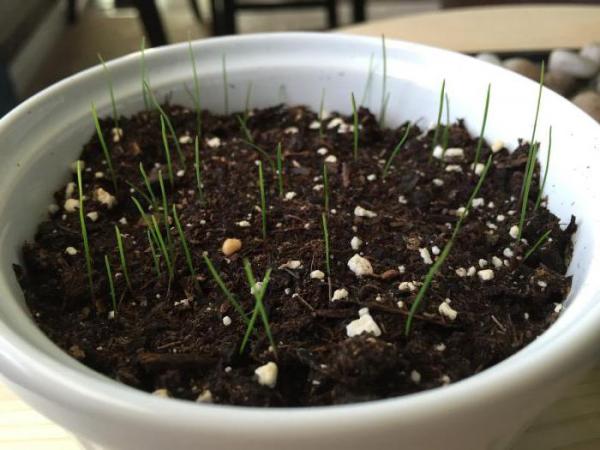

Seedlings


Seedlings before planting in the ground


Rhizome before division
To seat parts of the rhizome better during the awakening period of the plant. This method is more effective and gives quick results. Kortaderia is actively expanding, occupying new areas.
Plant care is very simple. Both spring pruning of the garden and seasonal peeling of dry and old leaves are essential for cortaderia. Systematic watering is only necessary for young and transplanted plants. Mature, rooted pampas grass can be moistened less frequently.
It perfectly tolerates periods of drought and heavy rain, resistant to pests, but sensitive to severe frosts. In regions with a temperate climate, pampaska should be wrapped in straw or foliage for overwintering during the winter.
It will not be superfluous to carry out spring feeding of the plant, this will give it strength and rich color.
The most cold-resistant varieties are Andes Silver, Patagonia, Pumila, Sunningdale Silver, Sello
Cortaderia is a plant that prefers large areas and growing in a lot of sun.
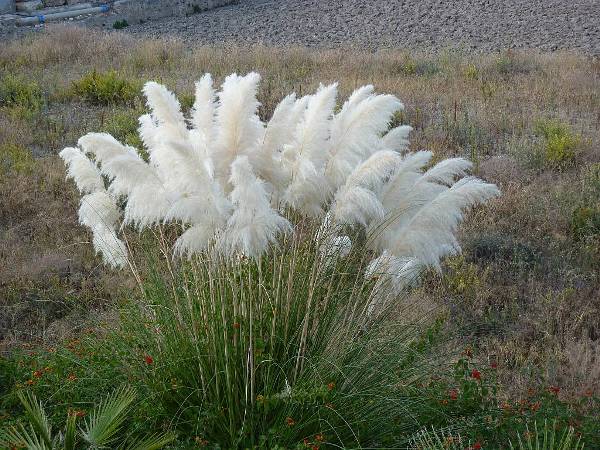

Sunningdale silver
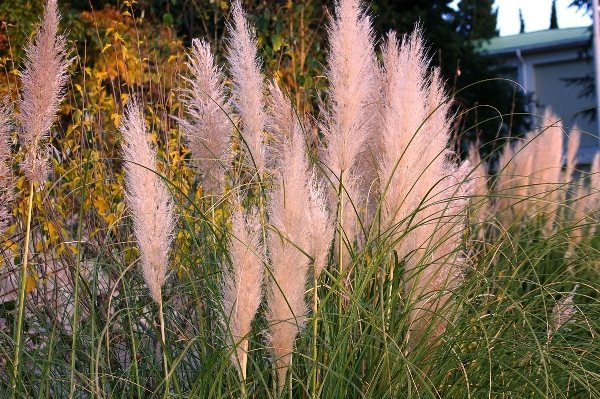

Pink cello
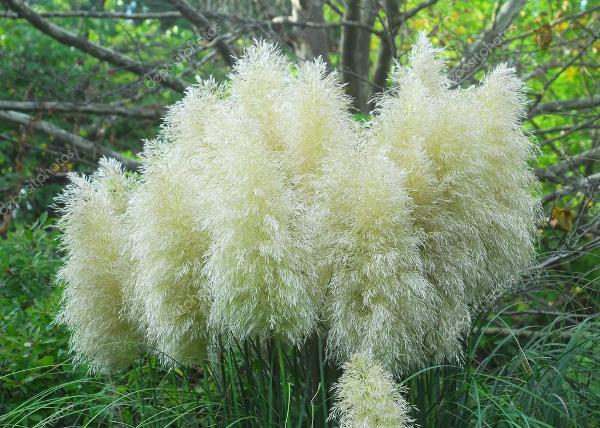

Pumila
Can't grow pampas grass (cortaderia), help with advice!
In our summer weather can be very different. This summer (July-August) is very hot and dry. +40 in the shade. And sometimes it is cold and very wet. Certainly not the pampas. But in terms of the amount of solar radiation and the number of sunny days per year, we are not far behind you. It's just that the cold comes early here. When I saw this miracle for the first time, I was generally "stunned": pampas grass almost a meter high without panicles. They grew it in bushes in a row, about 5 plants, so it was formed. Yes, it would not have gone into that path anymore. The leaves are not bright juicy green, but some kind of bluish. They live quite far from us, I sometimes went by. I saw her several times. But you know what's interesting? When I saw it, I didn't want to grow it at home! There was no desire, although usually the opposite is true. And here it is like a stupor.I’ve tried a lot, now I’ll ask about everything first, read books, forums, then I decide whether or not. And then the desire did not arise. At first I thought I was wrong. Well, it can't be that this weed in England needs shelter, but here it would be so-so easy to winter. So they managed to create acceptable conditions for it. Maybe in the fall the seeds were sown and grown in pots all winter, and then powerful plants were planted in the warmth in the ground. Because not in front of our eyes it all happened every day. Although I saw panicles. At first I even thought that I was mistaken. I reviewed all the books available to me. But I did not find anything similar. But in the Encyclopedia of Ornamental Plants of the Temperate Zone I found Sello's cortaderia about which it is written like this: “Originally from South America. Forms dense, large bumps with flowering stems up to 3 meters. The leaves are mostly basal, wide, extended at the end, finely toothed along the edge, gray-green, gracefully falling. Inflorescences are giant, pubescent. Used dried to decorate vases. Blooms in August-October. In central Russia, it requires shelter for the winter. " I read it and calmed down. I also realized that our summer is not enough for her to grow gigantic, as in warm regions. But beautiful!
Landing in the ground: choosing a place and soil
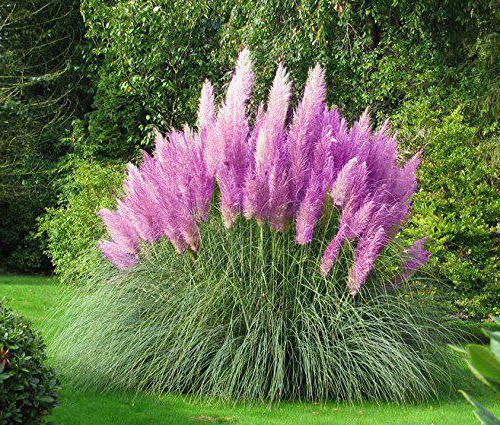

Planting the cortaderia into the ground is possible only after the cold weather has passed and the threat of frost has passed. At the same time, you can divide the mother bushes for the purpose of reproduction. For planting pampas grass, choose a permanent place immediately, as the subsequent transplant will be very difficult. The plant is undemanding to the soil and can develop both on stony soil and on swampy or very dry. However, he needs a lot of sun and light. Therefore, give preference to well-ventilated open areas.
Description
Cortaderia is a perennial herb. The stems grow up to 3 meters high and form a green fountain decorated with colored panicles on top. At the base of the stems, thin lanceolate leaves grow in large numbers, which makes the bush voluminous. Cortaderia grows over time in wide curtains... Since the plant has strong, deep roots, it is very difficult to get rid of it.
Panicles appear on the plant in August-October from the center of the leaf rosette. Their color is silver, pink, cream, white. Since the cortaderia has the ability to grow strongly, caring for it is reduced to limiting its growth so that the plant does not grow uncontrollably throughout the site. In the spring, the roots should be chopped down, preventing its further reproduction, and special barriers should be installed.
Growing cortaderia from seeds at home


Pampas grass cortaderia seeds as they look like in a photo
When seed propagation of cortaderia, seedlings should be grown. Sow pampas grass in March-April. It is advisable to stratify the seeds beforehand (keep them in the vegetable section of the refrigerator for about 1 month). For sowing, you will need flat containers and a sand and peat mixture. Fill containers with soil, level. You can plant several seeds in peat tablets.
- The seeds are very small - they should be spread less often over the surface of the soil with only light pressure, moistened with a fine spray.
- Germinate at room temperature, the room should be well ventilated. Provide diffused lighting.
Grass cortaderia planting seeds photo seedlings
- After 10-14 days, sprouts will appear.
- Water in moderation.
- Grow the grown plants very carefully in separate pots and grow in bright, diffused lighting, providing moderate watering and room temperature.
- A couple of weeks before transplanting into open ground, start hardening the seedlings: take them outside in the daytime for several hours, gradually increase this time, bringing them to a day.
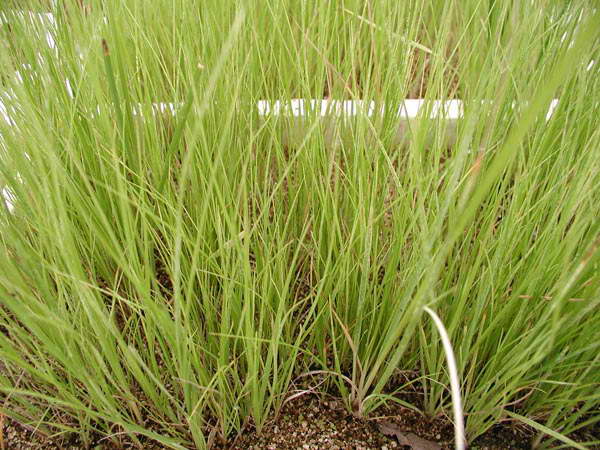

Grass cortaderia planting seeds photo seedlings
- Planting in open ground with the establishment of real heat.
- With seed reproduction, flowering occurs in the 5th year of growth.
Pests, diseases and prevention
Cortaderia is a hardy plant that is rarely damaged by pests. However, sometimes, especially in natural growing conditions, the plant is damaged by aphids and powdery mildew. At the same time, the leaves of the cortaderia wither, become faded. To solve this problem, it is necessary to treat the plants with a fungicide. Fertilizer is purchased in stores in liquid form.
In summer, a spider mite can settle on the grass, which will spoil the appearance of the bush, spoiling the leaves. In order to prevent damage, the plant is treated with insect fertilizer twice a year.
To prevent damage to the plant by various insects and pests, the bush is treated with insecticides in spring and summer.
If not properly cared for, mottling may appear on the grass. This condition occurs due to a lack of sunlight or, conversely, from an overabundance. Cortaderia prefers to grow in areas with diffused sunlight.
Ideal for autumn
At this time of year, many grasses look prettier - they release fluffy feathers and inflorescences. In addition to the pampas grass, which manifests its beauty in full, will also come in handy:
- Imperata cylindrica
In autumn, it takes on an intense red color. Creates scenic clusters. Will look great against the background of pampas grass. Loves fertile soil, sunny or slightly shaded area and permeable moist soil. Young plants need to be covered.
- Chinese Miscanthus (Miscanthus sinensis)
Tall grass, unusually decorative, reminiscent of reeds. In September, it releases fluffy, soft to the touch panicles. I like a warm and sunny place, fertile, moist soil. Zebrinus has bright stripes and Silberfeder produces long stems with a white stripe down the middle.
- Rod millet (Panicum virgatum)
Heavy Metal produces tough, upright bluish green shoots. In autumn, they take on a bright yellow color. The plant requires fertile soil and a bright, sunny place.
- Spartina pectinata (Spartina pectinata)
Quite a rare plant, it produces arched stems that look very picturesque. In autumn, they are painted in a straw color. The plant grows intensively. Loves a sunny place and moist soil.
If the article seemed interesting to you, please vote for it using your social network. And if you have something to add,
be sure to leave your comment on the site >>>
In ancient times, in the endless South American steppes, the pampas, this plant ruled and conquered the indigenous people with its power. The Indians worshiped the unique world of the Pampas, symbolizing for them the infinity of life in general and the frailty of one creature before eternity.
Cortaderia is part of the Cereal family. The botanical name is given to the plant from the Spanish word cortar, which means "to cut" - the leaves of the pampas grass are pointed at the edges and, if handled carelessly, can injure a person.
Dense thickets of cortaderia rise above the plain by 2-3, sometimes by 4 meters. In the old days, local residents hid in them from enemies and bad weather.
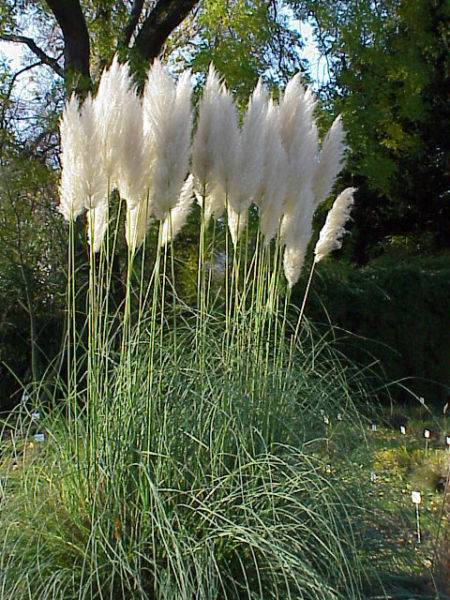

Photo: ru.wikipedia.org
A lonely growing clump of pampas grass reveals in all its splendor. Long, tough, elegantly curved leaves grow from the root to form a lush heap. They are painted in bluish-green or silvery-white tones, some varieties have longitudinal cream or white stripes.
From August to October, the pampas grass blooms. Silvery, pink, yellow or golden dense panicles rise high above the foliage and, swaying in the wind, fascinate a person.Women's panicles are more elegant - they are decorated with long silky hairs, which makes flowering plants especially attractive.
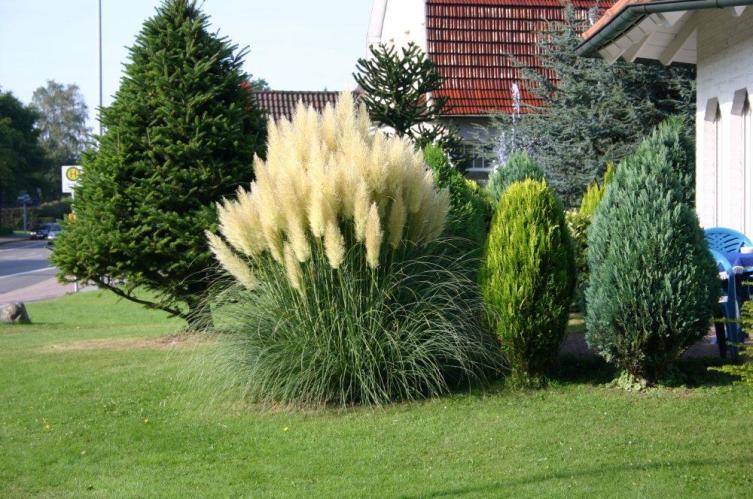

Photo: Source
One bush lives in one place for a long time, 40 years or more. According to 2007 data, such a long-lived cortaderia lives in one of the Japanese gardens: the height of its bush is about 4 meters, in the girth of this venerable plant is 7 meters.
Each plant during its life gives more than a million seeds and quickly conquers living space. If you do not limit the territory, then soon the pampas grass will show its aggressive character. In this regard, in some regions of the world, this plant is considered invasive, and in New Zealand and South Africa it is prohibited to sell and breed it.
Even burning does not help to cope with the invasion - a powerful root system remains unharmed, and soon the herbage is safely restored. Only with the help of chemicals is it possible to cope with this plant.


Photo: Source
As an ornamental plant, pampas grass is widely cultivated in western Europe and North America. In South America, its leaves are used as a raw material for the paper industry.
The most spectacular view of the cortaderia is in sunny, spacious areas. From it, you can create an original hedge, settle between rarely growing trees or near a reservoir. In large rocky gardens, pampas grass will look great in the company of boulders.
To fill the space between the sods of the cortaderia, such light-loving plants are suitable: echinacea, rudbeckia, yarrow, oregano, cosmea, various ornamental herbs.
In addition, cut inflorescences retain their decorative effect for a long time, and from the dried ones they make up winter flower compositions.
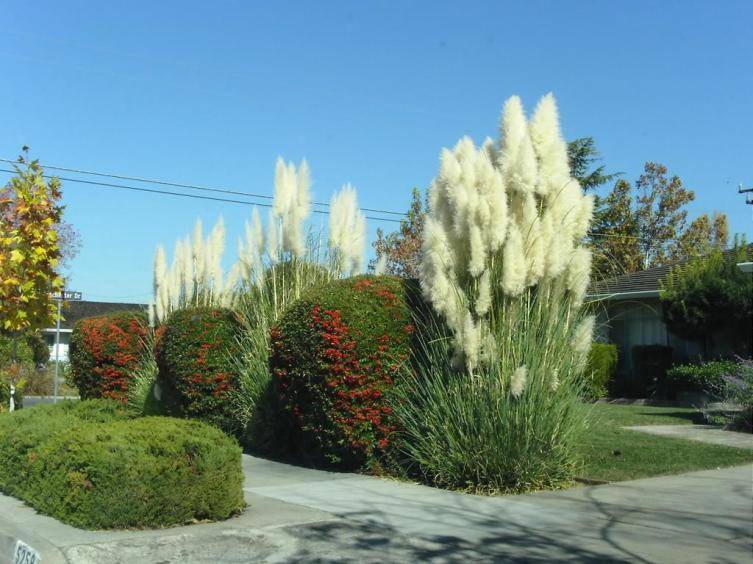

Photo: Source
Nowadays, many decorative varieties of cortaderia have been bred. The most popular of them are:
- Andes silver (silvery) - green leaves, two-meter stems with silvery-white panicles rise above them;
- Rendatleri - almost three meters high, the main advantage of the variety is large purple-pink inflorescences;
- Silver comet - has motley, bright green foliage, white inflorescences open on a stem 200-240 cm high.
You can settle pampas grass on almost any soil, preferably wet. This plant loves moisture, but it will steadily endure without watering, of course, to the detriment of decorativeness, and a sultry summer.
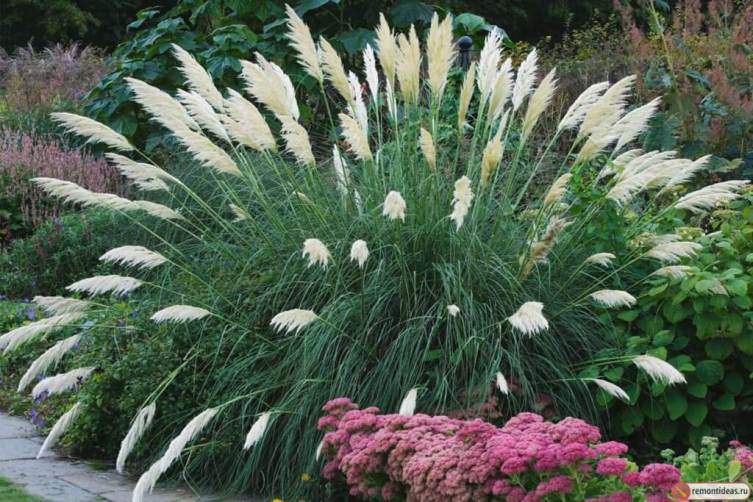

Photo: Source
If it is possible to water the cortaderia during the dry period, then one bush should be given two buckets of water a couple of times a week. In the spring, it is advisable to feed the pampas grass with mineral fertilizer; before feeding, it is necessary to cut off the old leaves and peduncles.
The pampas grass is propagated by seeds and sods.
The seeds can be found in flower shops. It is more difficult to acquire sodding - you have to look from amateurs or in nurseries.
Before planting, the seeds are stratified, in April they are sown for seedlings in room conditions, the seeding depth is about 3 mm. Seedlings appear in a couple of weeks. Watering the seedlings must be done with care so that the roots do not rot.
Before planting in the open ground, it is advisable to hold the kids for 3-5 days for hardening on the balcony or in a cozy place in the garden. With this method of reproduction, plants will delight you with flowering only after a few years.
It is much easier and faster to get a gorgeous flowering cortaderia by acquiring its rhizome in the spring. If you want to plant a bush from your cortaderia, it is not necessary to dig it out, it is enough to separate a part of the bush with a shovel and plant it in the right place together with an earthen lump.
Since the homeland of pampas grass is the subtropics, it is not difficult to grow it in warm regions. But in central Russia, overseas grass must be provided with a safe winter. To do this, cut the leaves at a height of 30-40 cm from the ground, cover the bush with spruce branches and cover with fallen leaves.You can tie the leaves into one bunch, press it to the ground and cover it with special covering materials or other improvised means.
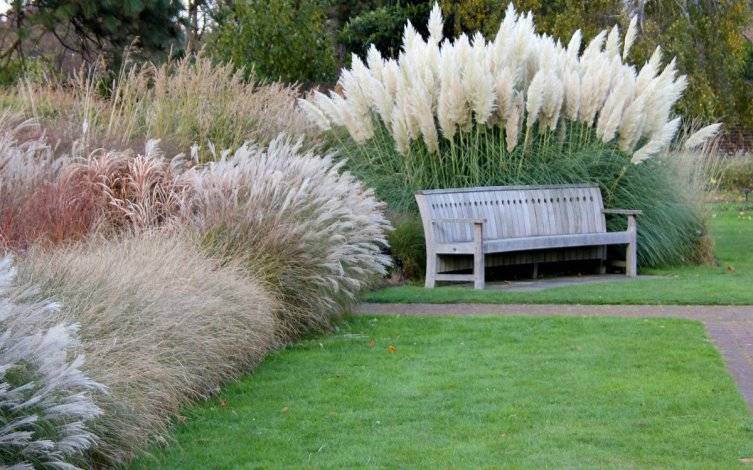

Photo: Source
Nature has endowed the pampas grass with excellent health, only sometimes it can get sick with powdery mildew or anthracnose. In such cases, it is necessary to remove the affected parts of the plants and carry out the treatment with a fungicide. In the dry season, spider mites sometimes appear on the cortaderia.
Having settled this unique plant of the American steppes on your site and creating comfortable living conditions for it, you will not be disappointed. Natural beauty and harmony will settle next to you, philosophical thoughts will visit you, filling life with meaning and joy of being. Looking at the high, up to 2-3 meters, sods, you will feel the spirit of eternity, tranquility and grace.
Briefly about culture
Cortaderia got its scientific name from the Spanish verb meaning "to cut." This happened because the edges of the leaves of the plant are very sharp. If you touch them carelessly, you can get hurt. Cortaderia is one common name for 23 species of perennials related to cereals or, as they are also called, bluegrass. Some members of this family are called "pampas grass".


Pampas grass
Their characteristic features are:
- the ability to form sod on the soil surface;
- panicle-like inflorescences that appear at the end of the summer period and delight the eye all winter;
- powerful root system that goes deep into the ground;
- high seed productivity, which makes the fight against the representative of cereals difficult.
Note! Before the seeds are ripe, the pampas grass is poisonous. During the ripening period, it becomes safe for human life and health.
Cortaderia wintering
Cortaderia is a fairly unpretentious plant that can easily withstand temperatures below zero. However, at a temperature of -12 degrees, the pampas grass can die. In severe frosts, it is worth insulating the plant and roots with roofing material or spruce branches. Dry leaves are also suitable as a root cover.
In late autumn, the perennial is pruned to 30-40 cm in height. In this case, the remaining stems of the plant are tied with a rope. A layer of covering material is poured over the roots of the grass.
If the perennial is not transferred to a warm room for the winter, then to withstand severe frosts, the bush should be completely covered with polyethylene or film. With the fall of snow, the plant under the film is covered with snow. This must be done carefully so as not to damage the foliage. This state of wintering will provide the cortaderia with the best conditions for maintaining their viability.


